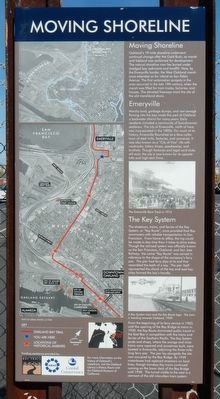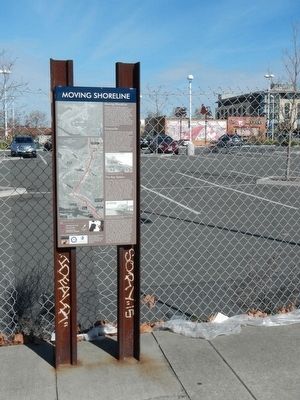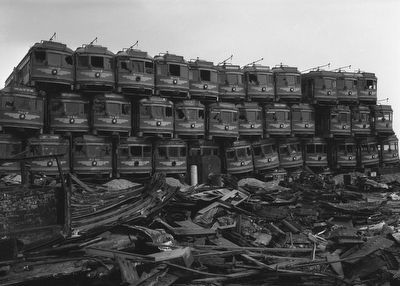Oakland in Alameda County, California — The American West (Pacific Coastal)
Moving Shoreline

Photographed By Barry Swackhamer, February 27, 2016
1. Moving Shoreline Marker
Captions: (top left) Map of the original bay shoreline.; (middle left) Aerial photograph showing the Key Route and Oakland Bay Trail.; (bottom left) Map orienting the above aerial photograph in relation to San Francisco Bay.; (middle right) The Emeryville Race Track in 1912.; (bottom right) A Key System train and the Key Route logo. The train is heading towards Oakland, 1939.
Oakland's 19-mile shoreline underwent continual change after the Gold Rush, as marsh and tideland was reclaimed for development. The natural shoreline now lies buried under dredged bay sediments and landfill. Here, by the Emeryville border, the West Oakland marsh once extended as far inland as San Pablo Avenue. The first reclamation projects in the area occurred in the late 19th century, when the marsh was filled for train tracks, factories, and houses. The elevated freeways mark the site of the old marshland shore
Marshy land, garbage dumps, and raw sewage flowing into the bay made this part of Oakland a backwater district for many years. Early residents included a community of Scandinavian seafarers. The city of Emeryville, north of here, was incorporated in the 1890s. For much of its history, Emeryville flourished as a blue-collar town of steel mills, factories, and canneries. It was also known as a "City of Vice" rife with racetracks, lottery shops, speakeasies, and brothels. Though factories and legal card clubs still exist, the city is now known for its upscale lofts and high-tech firms.
The streetcars, trains, and ferries of the Key System, or "Key Route", once provided East Bay commuters with reliable transportation to San Francisco. From home to office, the trip could be made in less time than it takes to drive today. Though the railroad system was officially known as the San Francisco, Oakland, and San Jose Railway, the name "Key Route" was coined in reference to the shape of the company's ferry pier. The pier had ferry slips at its end that resembled the teeth of a key. The pier itself represented the shank of the key and the east bay cities formed the key's handle.
From the beginning of its ferry service in 1903, until the opening of the Bay Bridge to trains in 1939, the Key Route dominated public transit in the East Bay in completion with the trains and ferries of the Southern Pacific. The Key System yards and shops, where the orange and silver trains were repaired and sometimes built, were located in Emeryville, adjoining the three-mile-long ferry pier. The pier lay alongside the site now occupied by the Bay Bridge. By 1949 motorbuses had replaced streetcars on local lines, though transbay Key trains continued running on the lower deck of the Bay Bridge until 1958. The tunnel visible to the west is a remnant of the old interurban train system.
Erected by San Francisco Bay Trail, Association of Bay Area Governments and Coastal Conservancy.
Topics. This historical marker is listed in these topic lists: Railroads & Streetcars • Waterways & Vessels. A significant historical year for this entry is 1903.
Location. 37° 49.699′ N, 122° 17.273′ W. Marker is in Oakland, California, in Alameda County. Marker is on Mandela Parkway near Horton Street, on the right when traveling west. Touch for map. Marker is at or near this postal address: 3701 Mandela Parkway, Emeryville CA 94608, United States of America. Touch for directions.
Other nearby markers. At least 8 other markers are within walking distance of this marker. Sherwin-Williams (approx. ¼ mile away); Welcome to the Emeryville Greenway (approx. ¼ mile away); Xučyun Park (Huchiun Park) (approx. 0.3 miles away); Judson Manufacturing (approx. 0.3 miles away); Two Emeryville Pioneers (approx. 0.3 miles away); Emeryville’s Mexican Heritage (approx. 0.4 miles away); Oakland Ball Park (approx. 0.4 miles away); Emeryville’s Horse Racetrack (approx. half a mile away).
Also see . . . Hobbyist's map offers glimpse into lost routes of East Bay's 1920s streetcars. Hoodline entry (Submitted on September 29, 2020, by Larry Gertner of New York, New York.)
Credits. This page was last revised on September 30, 2020. It was originally submitted on February 28, 2016, by Barry Swackhamer of Brentwood, California. This page has been viewed 568 times since then and 31 times this year. Photos: 1, 2, 3. submitted on February 28, 2016, by Barry Swackhamer of Brentwood, California.

